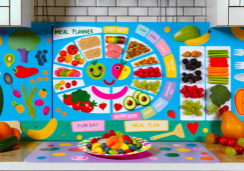5 Key Tips for Diabetes-Friendly Meal Planning
Balancing your blood sugar, bolstering your body's nutritional intake, and beating the boredom of dietary restrictions can seem like a daunting task when you're managing diabetes. You've likely been inundated with a plethora of do's and don'ts, which can leave you feeling overwhelmed about where to start.
As you navigate the complexities of creating diabetes-friendly meals, it's crucial to remember that small, consistent adjustments can lead to significant improvements in your overall health. Whether you're newly diagnosed or looking to refine your meal planning strategy, incorporating these five key tips could transform your approach to eating with diabetes.
While these suggestions might seem straightforward, they hold the potential to drastically alter your relationship with food and your control over diabetes—so why not explore the impact they could have on your daily life?
Prioritize Low-Glycemic Foods
When planning your meals, it's essential to choose low-glycemic foods like non-starchy vegetables, legumes, and whole grains, as they're key to managing your blood sugar levels effectively. These foods are the cornerstone of a Diabetes Meal Plan because they help prevent rapid spikes in blood glucose levels. By focusing on foods that release glucose slowly, you'll be creating healthy meals that support steady energy throughout the day.
In your Diabetes Diet, prioritize whole, unprocessed foods over refined and sugary options to maintain optimal blood sugar control. Include a balance of healthy fats and proteins with your low-glycemic choices. This combination aids in slowing down the absorption of glucose and contributes to feeling full and satisfied longer.
Be mindful of portion control. Even while selecting foods with a low glycemic index, it's important to keep an eye on your overall carbohydrate intake, as it directly impacts your blood sugar. Meal Planning with an emphasis on quality and quantity sets the foundation for healthy eating and better diabetes management.
Balance Carbohydrates Intake
Building on the importance of selecting low-glycemic foods, it's equally crucial to manage your carbohydrate intake to maintain blood sugar regulation throughout the day. To control your blood sugar effectively, monitor portion sizes and aim for a balanced intake of carbohydrates. It's not just about the quantity of carbs, but also the quality. Opt for complex carbohydrates found in whole grains, legumes, and vegetables, which provide sustained energy and help keep your blood sugar levels stable.
Incorporate proteins and healthy fats alongside your carbohydrates; this combination slows down digestion, preventing rapid blood sugar spikes. Diabetes food choices should focus on the whole meal, not just the individual components. Meal plans made with a registered dietitian can ensure that you're consuming the right mix of nutrients tailored to your personal health goals.
Simple carbohydrates, often high on the glycemic index, can lead to quick increases in blood sugar. Instead, choose foods with a low glycemic index to minimize your blood sugar's response. Managing diabetes effectively involves being mindful of these dietary choices and working them into your daily routine.
Incorporate Healthy Fats
Incorporating healthy fats into your diet is essential for managing blood sugar levels and supporting overall heart health. When meal planning for diabetes, it's crucial to select fats wisely to avoid exacerbating your condition. Here's how you can do it:
- Choose healthy fats like:
- Avocados
- Nuts
- Oils such as canola, olive, and peanut
These fats not only contribute to satiety but also aid in the absorption of vitamins. Remember, moderation is key to balancing calories.
- Avoid unhealthy fats, including:
- Saturated fats found in animal products
- Trans fats present in processed and fried foods
Opting for healthy fats over high-fat, processed options can help control weight loss, improve food choices, and provide a range of health benefits.
Cooking with healthy fats can enhance flavors, making your meals more enjoyable while sticking to the Diabetes Plate Method recommended by the American Diabetes Association. Pair these fats with lean protein and low-fat options to create well-rounded, nutrient-rich meals.
If you're unsure about how to incorporate these changes, consider consulting a dietitian for personalized advice tailored to your specific dietary needs.
Monitor Portion Sizes
To effectively manage diabetes, it's crucial to monitor portion sizes, utilizing tools like smaller plates and measuring cups to ensure accurate servings and prevent overconsumption. When you're mindful of the amount you eat, you're better able to control your blood sugar and maintain a diabetes-friendly diet.
Measure out serving sizes to keep tabs on how much you're eating. This practice is particularly helpful for weight loss and managing type 2 diabetes. Food labels can be a valuable resource, allowing you to understand the nutritional content and serving size of packaged foods. Don't forget to consider the glycemic index of foods, which affects blood sugar levels.
When dining out, be vigilant about the hefty portion sizes that are often served. You don't have to eat everything on your plate; instead, aim to match the portion sizes you adhere to at home. Dividing your plate into sections for vegetables, proteins, and whole grains can help you maintain a healthy diet that's rich in nutrients and appropriate in quantity.
Schedule Consistent Meal Times
While keeping an eye on portion sizes is essential for managing diabetes, establishing regular meal times further supports blood sugar regulation and overall health. Planning meals at regular times can help keep your blood sugar levels stable throughout the day. It's important to stick to a consistent eating plan that includes three meals a day, plus snacks if necessary.
Here's how you can schedule your meals and snacks effectively:
- Plan Meals
- Use the plate method to balance vegetables, lean protein, and whole grains.
- Include small portions of fruits and low-fat dairy.
- Keep Track
- Avoid skipping meals to prevent overeating.
- Choose water, coffee, or unsweetened tea over sugary drinks.
Sticking to set meal times makes it easier to manage your dietary intake and ensures that your body receives nutrients at times when it's ready to process them efficiently. Remember, meals and snacks aren't just about eating; they're about nourishing your body.
Frequently Asked Questions
What Should a Diabetic Meal Plan Look Like?
Your diabetic meal plan should include balanced portions with a focus on carb counting, a low glycemic index, and high fiber intake. Opt for sugar substitutes, diverse nutrients, and smart snack choices.
What Are Some Healthy Eating Tips for People With Diabetes?
You should focus on balanced carbohydrates, mindful snacking, and understanding the glycemic index. Practicing portion control, choosing nutrient-dense foods, using sugar alternatives, and valuing hydration are crucial. Increase fiber intake and consume heart-healthy fats and anti-inflammatory spices.
What Is the Best Eating Schedule for Diabetics?
You should eat regularly to manage your blood sugar. Portion control and carb counting are key. Choose snacks wisely, stay hydrated, and coordinate meals with insulin and physical activity for optimal health.
What Is the Most Important Consideration When Preparing Meals for Your Diabetic Client?
You'll want to focus on nutrient balance, portion control, and food variety. Consider the glycemic index, do carbohydrate counting, and incorporate personal preferences for effective blood sugar monitoring and insulin management.
Conclusion
To manage your diabetes effectively, there are several key strategies you can implement. First and foremost, it is important to choose low-glycemic foods that won't spike your blood sugar. This means opting for foods that have a minimal impact on your blood glucose levels. Additionally, it is crucial to balance your carbohydrate intake. Carbohydrates have the biggest impact on blood sugar, so monitoring the amount you consume can help maintain stable levels. Moreover, don't forget to include healthy fats in your diet. Healthy fats are essential for overall health and can help regulate blood sugar levels. Another important aspect to consider is portion control. Keeping an eye on portion sizes can help maintain your energy levels and control your weight. Lastly, it is beneficial to eat at consistent times. By establishing regular eating patterns, you can stabilize your blood sugar levels throughout the day. By following these practical, evidence-based tips, you'll nourish your body and take charge of your diabetes with confidence.










